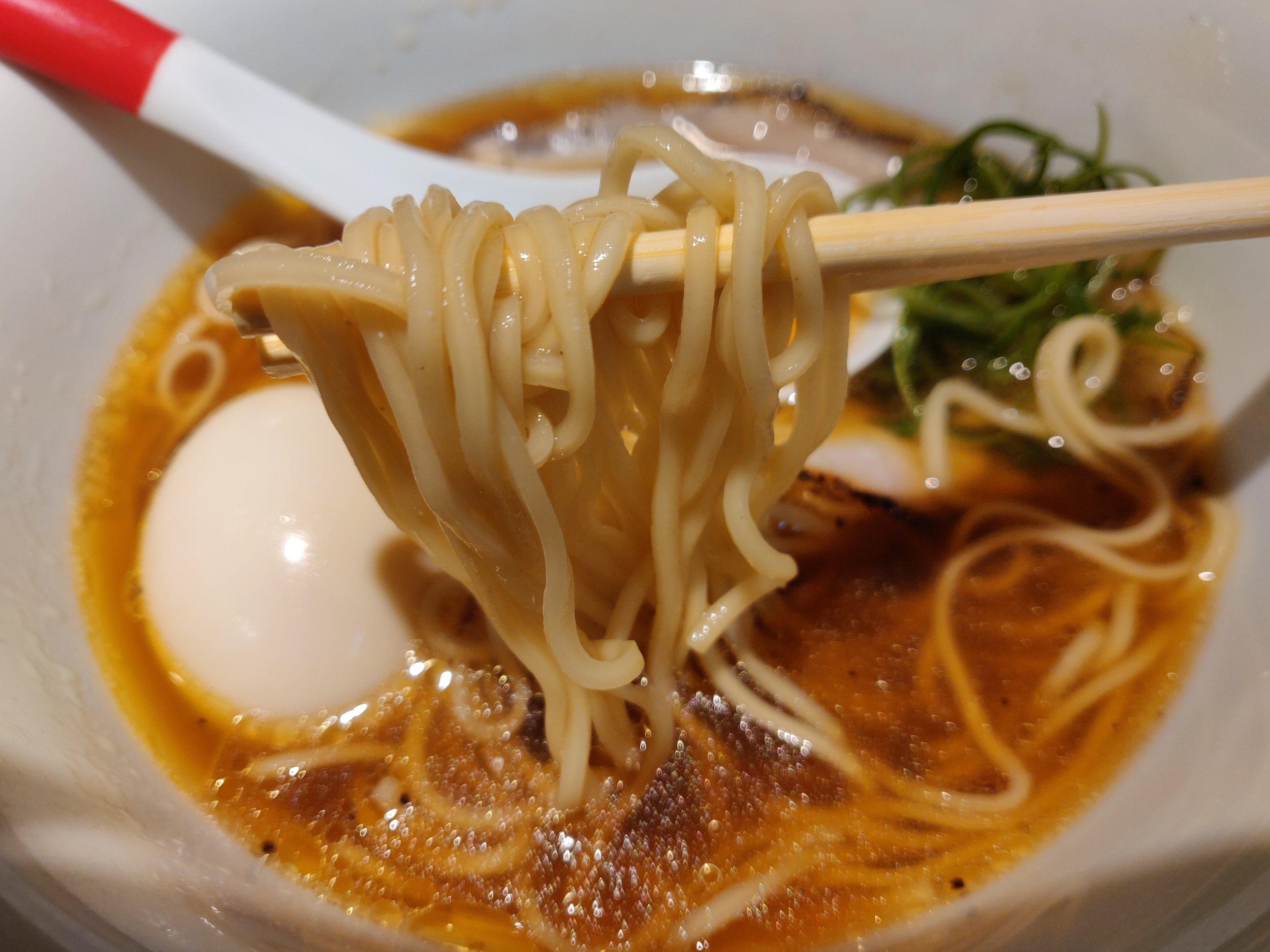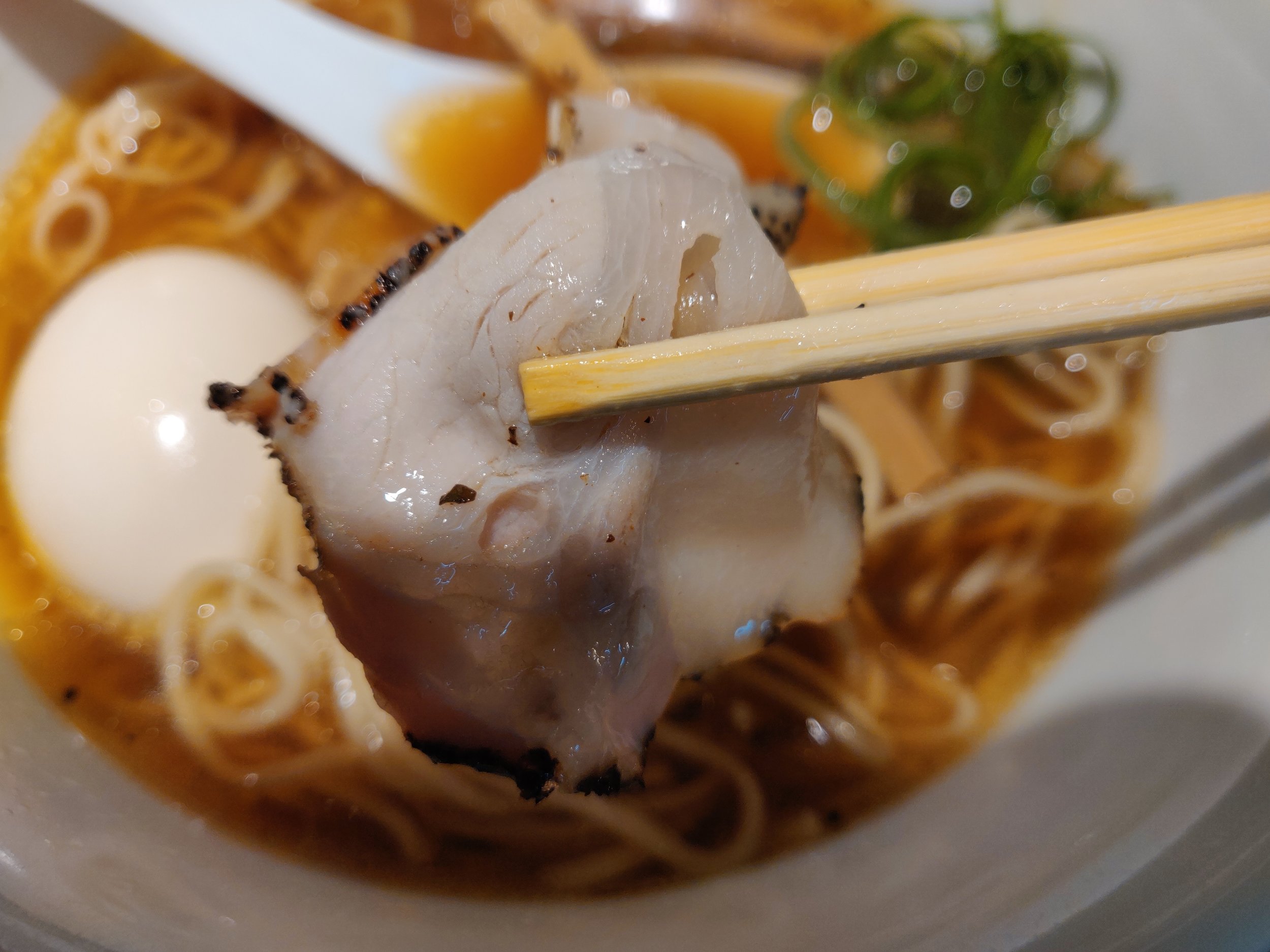Japanese Soba Noodles Tsuta (Japanese Soba Noodles 蔦); First Michelin Star Ramen Ever, Sugamo
So I’m a bit late to the party in terms of reviewing Japanese Soba Noodles Tsuta, but I haven’t gone in quite a while and I needed a refresher before I could write anything with substance. I’ve been dreading going since the lunch system needs a bit of determination to get through, but I heard that dinners on weekdays are first come, first serve with shorter lines so I decided to make a visit when I was in the area for work. Once I got to the restaurant, I was about 12th in line at around 16:45 for a 17:00 opening so I was excited to get in and out as quickly as possible. Boy, was I wrong, and I will try to be as gentle as possible, but I think a course on ramen etiquette is in order for certain number of prospective diners of Tsuta. I hope my readers will respect what I have to say about it a bit later on, but here goes my review for the first Michelin Star ramen restaurant in the world.
Shop hours for Tsuta are 11:00-15:00 for lunch and 17:00-20:00 for dinner, Thursday-Monday. On Tuesdays they are open only for lunch, 11:00-15:00 and are closed entirely on Wednesdays. Since many tourists and foreigners come to Tsuta, they have English menus for you and I took the liberty to take a picture for you to see before you head out there. One thing to note, the Miso Ramen is only during lunch hours and conversely the Rich Salmon Ramen is only during dinner hours. Due to the sheer number of customers Tsuta gets on a daily basis for lunch, they have a specific system in place for reserving your spot for a bowl. Starting at approximately 7:00 am, Tsuta will allow customers to come in and reserve a specific time period from which to eat at. The time slots you can choose from are 11:00-12:00, 12:00-13:00, 13:00-14:00, and finally 14:00-15:00. Check their twitter in the morning for availability of each time slot, but you’ll usually have your choice of time if you arrive at 7. Weekends are busier than weekdays so make sure to plan ahead if you make your way to Tsuta on a Saturday or Sunday just in case you can’t get a spot. When you choose your time slot they ask you to leave 1000 yen as deposit for your spot. You get your money back if you arrive during your alloted time slot, but you will lose it if you don’t show up. You can not reserve for more than one so make sure your entire group is there to get the ticket in the morning. Dinner, however, is a first come first serve basis and so you’ll line up like most ramen restaurants. The shop is located on the first floor of an apartment complex and the line forms in the hallway to the entrance of the apartment. Once you get to the edge, you’ll need to form a second line on the opposite side of the hallway and loop around towards the street if it gets that long. A shop staff will come out periodically to make sure you’re lined up correctly. Now comes the problem I had when I took my place in line. Customers must form the line in this particular way to avoid confusion and you must stay in your place during the entirety of the wait. There is a little ledge on the street side of the restaurant that makes for a great place to sit, but is towards the end of the line. I had no idea that the people there were just sitting there as they were too tired to stand, so a line began to form behind them in the street. The reason Tsuta instructs people to wait in the hallway is because the area of Sugamo in which they are located is in a residential area. They’ve received many complaints about the noise and foot traffic the restaurant brings which is why they are considering a move some time later this year. If you end up lining up during the dinner hours, please respect the residents of the area by keeping your proper place in line to squeeze in to the hallway and by keeping your voices down. The group in front, not only were they taking turns keeping their place in line, were talking obnoxiously loud and smoking right outside the restaurant. So that future Tsuta patrons can enjoy bowls, please be mindful and respectful. It would be a shame if the restaurant were to close down due to complaints they get about customers. OK, hopefully this covers the entire etiquette of queuing in Japan and at Tsuta and can move on to my review. Anyways, I was hoping to just kill two birds with one stone by ordering both their Shoyu and Shio ramen, but they told me that I can only order one so I opted for the Shoyu Ramen. I also ordered a bowl of their Smoked Pork over rice to supplement my ramen.
So first off, the Tokusei Shoyu Ramen. The most distinct feature, appearance wise, of Tsuta’s shoyu ramen is definitely their black truffle puree which you can see a dollop of on top of their roast pork char siu slice. Be sure to mix the sauce in to your soup half way through so you can taste the flavors of the soup as is, and with the black truffle mixed in. The puree is quite condensed so do it earlier rather than later or else it could make your ramen tasting really strongly of the truffles. Soup is a chintan, light chicken broth base with a soy sauce based tare seasoning. You can tell a bit of black truffle oil is also used as even without the puree, the distinct truffle flavors hit your taste buds. The soup is hard to describe as the intense truffle flavors really mask the flavors of the broth. I get some good, beautiful chicken flavors, but it tends to be overshadowed by the intensity of the truffles. A bit of chicken oil is added to the tare seasoning and you can see a layer of it floating on the surface of the soup, but its quite clean and doesn’t leave any residue in your mouth when you take a spoonful. I was actually a bit disappointed as I would much rather have a bowl of amazing broth than one that is hidden under a barrage of tare seasoning and toppings, but I can see how some might enjoy it.
The noodles were chewy, and a bit dense with a good bite. It really leaves enough texture for a meaty bite and it doesn’t lose out to the black truffle flavor. I was a bit disappointed at how haphazardly the noodles were placed in my bowl, but maybe I should temper my expectations. The roast pork char siu is thinly cut about a couple centimeters thick and has a bit of char around the edges. As the pork is smoked, you really get a kind of Texas BBQ vibe with its aroma and flavor, but it’s cut so thin that its not overbearing. Adds the perfect amount of subtle flavors that tend to get masked by the truffles. As I ordered the Tokusei, I received four slices of the smoked pork and one of the thicker Chinese style roast pork. The roast pork was meaty and had a nice chew, but since the dollop of the puree was placed on top of it, honestly it didn’t have any other flavor besides the truffle. The green onions were a really great touch using a ridiculously fresh and crunchy variety that really helps cut through the intense flavors and adds a nice variety in texture. The egg was soft boiled with a nice milky finish that mellowed out the soup a bit which I found quite pleasing at the latter half of my bowl.
The highlight of my meal, for better or worse, was the smoked pork over rice bowl. It seems quite odd for me to say that a rice bowl was the best part at a Michelin Star ramen shop, but honestly this was fantastic. Using the smoked pork from the ramen, the slices are veiled carefully over a bed of pillowy, soft white rice with a grated onion, shoyu sauce drizzled on top. The bowl is finished with a bit of furikake (Japanese rice seasoning) which cover both the pork and the rice. So the smoked pork loses out to the intense flavors in the ramen, but shines through in this rice bowl. The grated onion soy sauce dressing was fantastic adding a bit of tanginess and sweetness that pairs incredibly well with the smoky pork. I would relate it to a good bbq sauce, but a Japanese iteration. It both cuts through the fattiness of the pork and adds great flavors that I ended up taking a bit of the smoked pork from my ramen and putting some of the dressing on to eat with my rice. I highly recommend supplementing your meal with this rice bowl as the ramen wasn’t quite as filling as I would have liked.
It might sound like I didn’t enjoy my meal at Tsuta, but honestly it was a solid ramen restaurant. I just had some higher expectations for it as it is the first Michelin Star ramen restaurant in the world. I expected a stronger soup that the restaurant would pride themselves in rather than one that is masked by an expensive ingredient like truffles. Honestly, if I wanted to eat so much truffles in my meal I would have just gone to a French restaurant. It felt a bit gimmicky and takes away from the essence of ramen. Presentation was a bit lackluster for a Michelin Star restaurant as well. I would have expected some exemplary table setting, or at the very minimum amazing food presentation, but my bowl looked quite disoriented. If this was any other restaurant, I honestly wouldn’t have mind, but it just blew me away that this lackluster performance grants them a star above some of the other shops in Tokyo. And of course other factors were a bit out of the shop’s hands such as the customers not knowing how to line up and the absurdly loud baby who sat next to me crying the entire meal, but I don’t think it would have been out of the reach of a Michelin restaurant to try and do something about it. Again, neither would have bothered me at a regular ramen shop, but for one with such high reputation and prestige I expected a bit more.
I do find it great that ramen is finally getting the attention it deserves from Western media and some stores perform well enough to warrant a star, but if I’m being completely honest, you can do without going to the 3 Michelin Star ramen restaurants in Tokyo. You’re better off spending your time not waking up at 7 am for an 11 am ramen bowl or lining up among a crowd of other tourists and foreigners. A number of shops will give you better service and better ramen at half the effort you’ll need to put in to dine here. If you’re determined to eat at a Michelin Star restaurant, Japan has the most Michelin Stars of any country in the world. Try any of the other countless restaurants Japan has to offer and book yourself a reservations at any of those places. You’re likely not missing out on a place you can essentially try in the coming years as they expand abroad.





